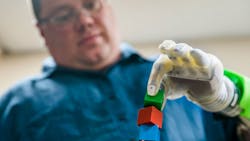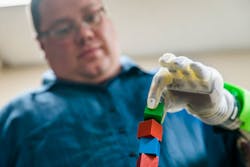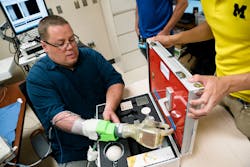Patients take Mind-Controlled Prosthetics for a Test Drive
In what represents a major advance in mind-controlled prosthetics for amputees, biomedical researchers at the University of Michigan have tapped faint, latent signals from arm nerves and amplified them to carry out real-time, intuitive control of the fingers on a robotic hand.
To do this, the researchers had to develop a way to safely harness nerve endings, separate thick nerve bundles into smaller fibers that provide more precise control and amplify the signals coming through those nerves. The approach involves tiny muscle grafts and machine learning algorithms borrowed from the brain-machine interface field.
Intuitive prosthetic control works on the first try.
“You can make a prosthetic hand do a lot of things, but that doesn’t mean the person is intuitively controlling it. The difference is when it works on the first try just by thinking about it, and that’s what our approach offers,” said Cindy Chestek, a professor of biomedical engineering. “This worked the very first time we tried it. There’s no learning for the participants. All of the learning happens in our algorithms. That’s different from other approaches.”
Participants in the study could pick up blocks with a pincer grasp; move their thumb in a continuous motion, rather than have to choose from two positions; lift spherically shaped objects; and even play in a version of Rock, Paper, Scissors called Rock, Paper, Pliers.
“It’s like you have a hand again,” said study participant Joe Hamilton, who lost his arm in a fireworks accident in 2013. “You can pretty much do anything you can do with a real hand with that hand. It brings you back to a sense of normalcy.”
One of the biggest challenges in mind-controlled prosthetics is using a strong and stable nerve signal to feed the bionic limb. Some research groups, those working in the brain-machine interface field, go to the primary source: the brain. This is necessary when working with people who are paralyzed. But it’s invasive and high-risk.
For amputees, the peripheral nerves—the network of nerves that fan out from the brain and spinal cord—have yet to be used for several tasks. The signals they carry are small. Most ways of picking up those signals involved electrodes that tap into the nerves by force. These “nails in nerves,” as researchers sometimes call the invasive electrodes, lead to scar tissue on the nerve, which muddles the already faint signal over time.
The UM team came up with a better way. They wrapped tiny muscle grafts around nerve endings in the participants’ arms. These regenerative peripheral nerve interfaces offer severed nerves new tissue to latch on to. This prevents the growth of nerve masses called neuromas that lead to phantom limb pain. It also gives the nerves a boost, as the muscle grafts amplify the nerve signals. In an early experiment, two patients had electrodes implanted in their muscle grafts, and the electrodes could record the nerve signals and pass them to a prosthetic hand in real time.
“To my knowledge, we’ve gotten the largest voltage recorded from a nerve compared to all previous results,” Chestek said. “In previous approaches, you might get 5 microvolts or 50 microvolts—very, very small signals. We’ve seen the first ever millivolt signals.
“So now we can access the signals associated with individual thumb movement, multi-degrees-of-freedom thumb movement, and control of individual fingers. This opens whole new world for people who are upper limb prosthesis users.”
And their interface has already lasted years. Others degrade within months due to scar tissue.
The findings also open up new possibilities for the field, says Chestek, whose expertise is in real-time machine learning algorithms that translate neural signals into movement intent.
“What we found is that nerve signals are good enough to apply the whole world of methods we learned in brain control algorithms to nerve control,” she says.
The approach also generates signals for finer movements than what today’s prosthetic hands are capable of.


